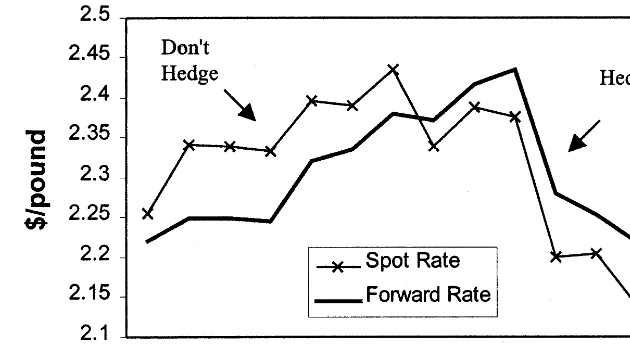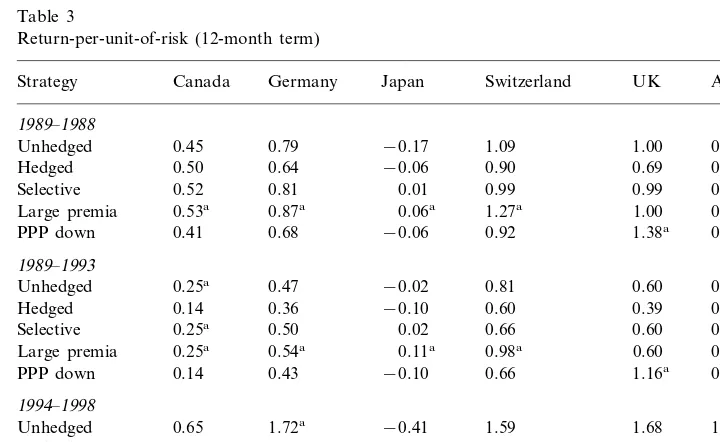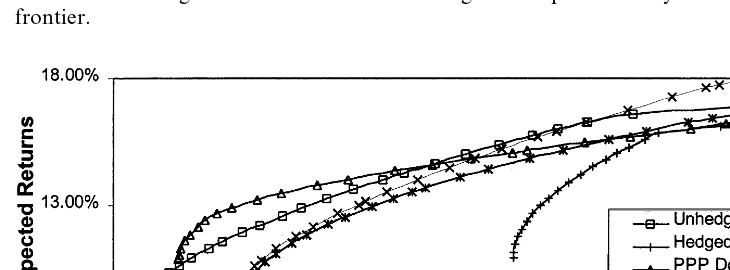11 (2001) 213 – 223
To hedge or not to hedge: the performance of
simple strategies for hedging foreign exchange
risk
Matthew R. Morey
a, Marc W. Simpson
b,*
aLubin School of Business,Pace Uni
6ersity,New York,NY10038,USA bDi
6ision of Finance and Economics,Lewis College of Business,Marshall Uni6ersity,Huntington, WV25755,USA
Received 13 October 1999; accepted 20 March 2000
Abstract
This paper investigates the efficacy of simple strategies for hedging foreign exchange risk. The strategies are: to always hedge, to never hedge, to hedge when the forward rate is at a premium, to hedge only when the premium is large, and a strategy based upon relative purchasing power parity. We find a strategy which hedges based upon large premia generally outperforms the other strategies for the period 1989 – 1998. Moreover, we document that in every sample and time horizon period, an unhedged strategy performs better than a hedged strategy. We illustrate our results using a data set of five countries. © 2001 Elsevier Science B.V. All rights reserved.
JEL classification:F31
Keywords:Selective currency hedging; Purchasing power parity; Forward exchange premium
www.elsevier.com/locate/econbase
1. Introduction
The merits of diversifying securities portfolios internationally have long been recognized. Concomitant with such diversification is the assumption of foreign
* Corresponding author. Tel.: +1-304-6962667; fax:+1-304-6963662.
E-mail addresses: [email protected] (M.R. Morey), [email protected] (M.W. Simp-son).
M.R.Morey,M.W.Simpson/J.of Multi.Fin.Manag.11 (2001) 213 – 223
214
exchange risk. As was pointed out by Eaker and Grant (1990) and Eun and Resnick (1997), portfolio managers may not merely wish to mitigate foreign exchange risk, but may also wish to take advantage of foreign currency returns. This paper examines, with different data, the efficacy of those hedging strategies explored by Eaker and Grant. Those strategies being: a) to leave foreign exchange exposures unhedged; b) to always hedge exchange risk with forward contracts; and c) to selectively hedge such risk, buying forward contracts only when the forward rate is at a premium. Moreover, we also look at two additional strategies. One is a modification of the selective hedging rule. It requires the investor to purchase a forward contract when the forward rate is at a premium only when such a premium is ‘large’ historically. The other strategy is based upon a relative purchasing power parity (ppp) equilibrium exchange rate, and stipulates that one hedge foreign exchange risk when the current spot rate is above its relative purchasing power parity equilibrium rate.
Like Eaker and Grant (1990) we examine the relative performance of the strategies using ex post efficient frontiers. In addition, we use return per unit of risk measures to compare the strategies. We find the ‘large’ premia strategy generally outperforms the other strategies. Moreover, we document that every sample and time horizon period, an unhedged strategy performs better than a hedged strategy. The rest of the paper is organized as follows. Section 2 discusses the data used in the analysis. Section 3 discusses the hedging strategies. Section 4 discusses the results of the hedging strategies. Section 5 concludes the paper.
2. Data
There are four types of data used in the analysis: spot exchange rates, forward exchange rates, share price indexes, and to measure purchasing power parity, consumer price indexes.
The spot and forward data correspond to the bid-price of the last trading day of each month for the months between January 1974 and December 1998. The data from 1974 to 1992 are from the Harris Data Banks tapes and the data subsequent to this are from General du Banque, New York and the Federal Reserve Bank of Chicago.1 The exchange rate data are in U.S. Dollar terms and are for five countries: Canada, Germany, Japan, Switzerland, and the United Kingdom. The forward rate data are for 3-months forward and for 1-year forward.
The Consumer Price Index and share price index data are from the International Financial Statistics database. They are all calculated using a base year of 1990.
All hedged positions are equal to the size of the foreign equity position at the beginning of the holding period, as the size of the position at the end of the holding period would not be known at the time the hedging decision would have been made.
Perold and Schulman (1988) indicate that forward foreign exchange transactions costs are approximately equal to one-half the bid ask spread. Table 1 shows the estimated transactions costs for 3-month and 1-year forward contracts, respectively, for each of the currencies. The transaction costs in Table 1 were estimated using the forward bid and ask rates for the time period January 1991 through December 1998. The forward rates used in calculating the transaction costs are from General du Banque, New York. The transaction costs were not incorporated into the rates of return. It should be noted that as the selective hedging strategy involves fewer forward transactions than the hedged strategy it incurs lower transactions costs. Likewise the large premia strategy would incur lower transactions costs than either the selective or the hedged strategies. The percentage of the time one would hedge using the various strategies is reported in Table 2.
3. Hedging strategies
The first of the hedging strategies considered is to simply never hedge. That is, under this strategy one never purchases a forward foreign exchange contract to cover exchange rate risk. For simplicity this strategy will be referred to as the ‘unhedged’ strategy. An alternative strategy would be to always hedge foreign exchange risk. This strategy will be referred to as the ‘hedged’ strategy.
The ‘selective’ hedging strategy is based on the empirical finding that for data from the 1970s and early 1980s a simple random walk outperforms almost all standard models of exchange rate determination in terms of predicting changes in future spot exchange rates (Meese and Rogoff, 1983). This implies that the current spot rate is a better predictor of the future spot rate than is the current forward rate. Thus, if the forward rate is at a premium, hedging offers higher expected returns. If the forward rate is at a discount, then leaving the exchange risk unhedged offers higher expected returns.
Table 1
Estimated transactions costsa
Country Transactions costs on exchange contracts
3-months forward 1-year forward
M
Percentage of the time one hedgesa
Term
Country Strategies
Selective PPP down Large premia
1st (%) 2nd (%) Whole (%) 1st (%) 2nd (%)
Whole (%) 1st (%) 2nd (%) Whole (%)
97 0 15 2 25
48 60
Canada 3 months 46 32
100 12 12 0 23
aThis table shows the percentage of the time one would hedge using the various strategies, over two different terms, for the five countries. The results
A fourth strategy involves hedging when the forward rate is at a premium, but only if the premium is large historically. This will be referred to as the ‘large premia’ strategy. To determine when a premium is ‘large’ we use a moving average of the absolute value of the premia.2 When the absolute value of the current premium is greater than the moving average we define this premium as ‘large’. To construct the moving average we use the previous 36 months of data.3
The logic behind the large premia strategy is that in the selective hedging strategy there may be times one hedges when, in hindsight, he or she would have earned higher returns by not hedging. This occurs when the forward rate is initially at a premium, but by the end of the term, the spot rate ends up be greater than the forward rate at which the contract was purchased. This is less likely to occur if the forward premium is large, simply because the rise in the spot rate necessary to cause the selective hedging rule to fail will be that much larger.
A fifth strategy based on a relative purchasing power parity equilibrium exchange rate requires that one hedge whenever the current spot rate is above the ppp equilibrium, as this would suggest that spot rates might be falling. This strategy will be referred to as the ‘ppp down’ strategy, because one hedges when ppp suggests that the spot rate is going down.
For the concept of relative ppp, we use the inflation rates in two countries to find the implied change in the purchasing power parity equilibrium exchange rate. However, this does not offer a means of finding the level of the exchange rate. Hakkio (1992) suggests assuming that ppp holds for a specific period. One could then use that period’s observed exchange rate as a base and then map the equilibrium exchange rate forward and backward from that observation using the difference in inflation in the two countries. The level of these equilibrium exchange rates, of course, would be biased by the choice of the base period. To mitigate this bias one could choose several base periods and take the average of the equilibrium exchange rates so generated. For our analysis we have created the ppp equilibrium exchange rate by using the 36 monthly observations in the base period of January 1980 – December 1982. This period was chosen as the base because Hakkio (1992) has argued that the exchange rate was in equilibrium during this period.4The logic of hedging when ppp indicates that the spot rate will be falling in the future is that (a) if the forward rate is at a premium, hedging offers greater expected returns; and (b) even if the forward rate is at a discount, the spot rate may fall below the current forward rate.
2Of course assuming that an average holds implies that the premia are stationary processes. A number of papers including Ballie and Bollerslev (1994) have documented that forward exchange rate premia are stationary processes.
3We also used other time periods to construct the moving average with very similar results and conclusions presented in the paper. Indeed, we used a 60 month moving average and a moving average that incorporated all past data till 1974. These results are available from the authors upon request.
M.R.Morey,M.W.Simpson/J.of Multi.Fin.Manag.11 (2001) 213 – 223
218
Fig. 1. Selective hedge.
Figs. 1 – 3 illustrate, for the different strategies, when hedging is undertaken and when the foreign exchange exposure is left unhedged.
4. Results
The results are presented in two sections: return per unit of risk — which is the mean return divided by the standard deviation of the returns, and ex post efficiency frontiers.
Fig. 3. PPP down.
4.1. Return per unit of risk
The return per unit of risk measures are shown on Tables 3 and 4. Table 3 reports the return per unit of risk for Canada, Germany, Japan, Switzerland and the UK. for the five strategies assuming a time horizon time of 12 months. We use
Table 3
Return-per-unit-of-risk (12-month term)
Average Strategy Canada Germany Japan Switzerland UK
1989–1988
Unhedged 0.45 0.79 −0.17 1.09 1.00 0.63
0.50 0.64 −0.06 0.90 0.69 0.53
Hedged
0.67
Selective 0.52 0.81 0.01 0.99 0.99
1.27a
Unhedged 0.47 −0.02 0.81 0.60
0.28
0.36 −0.10 0.60
Hedged 0.14 0.39
0.66
Selective 0.25a 0.50 0.02 0.60 0.41
0.25a 0.54a 0.11a 0.98a 0.60 0.50a
Unhedged 1.72a −0.41 1.59 1.68
0.89
Selective 0.87 1.32 0.00a 1.51 1.67
0.87 1.59
Large premia −0.02 1.89a 1.68 1.20a
0.69 1.07 0.00a 1.30 1.69a 0.95
PPP down
M.R.Morey,M.W.Simpson/J.of Multi.Fin.Manag.11 (2001) 213 – 223
220
Table 4
Return-per-unit-of-risk (3-month term)
Strategy Canada Germany Japan Switzerland UK Average
1989–1998
Unhedged 0.16 0.37 −0.08 0.52 0.35 0.26
Hedged 0.25 0.29 −0.05 0.43 0.26 0.24
Selective 0.31a 0.36 0.03 0.57a 0.43a 0.34a
Large premia 0.21 0.42a 0.07a 0.56 0.35 0.32
PPP down 0.16 0.34 −0.05 0.43 0.40 0.26
1989–1993
Unhedged 0.15 0.27 −0.01 0.40 0.24 0.21
Hedged 0.15 0.20 −0.09 0.32 0.22 0.16
Selective 0.26a 0.24 0.02 0.45 0.38 0.27a
Large premia 0.15 0.32 0.06a 0.47a 0.24 0.25
PPP down 0.16 0.34a −0.05 0.43 0.40a 0.20
1994–1998
Unhedged 0.18 0.50 −0.02 0.64 0.51 0.36
Hedged 0.34 0.38 0.00 0.53 0.30 0.31
Selective 0.36a 0.49 0.06 0.70a 0.48 0.42a
Large premia 0.25 0.53a 0.09a 0.64 0.52a 0.41
PPP down 0.18 0.43 0.00 0.53 0.50 0.33
aIndicates the strategy with the highest value.
the 12-month forward rate to calculate any returns that are hedged using the various strategies. The first section of the Table contains the 1989 – 1998 sample and the following two sections contain the 1989 – 1993 and 1994 – 1998 subsamples. We only examine the post 1988 data since this is after the time that Eaker and Grant conduct their study.5
Table 4 reports the results for the same group of countries over the same time periods, except that we use a shorter time horizon of 3 months. For this horizon we use the 3-month forward rate to calculate the hedged returns.
The results show several interesting findings. First, in the 12-month horizon period, the large premia strategy generally outperforms the other strategies. This is the case for most countries and for both of the subsamples as well. The average return per unit risk is the highest for the large premia strategy in all three samples. Further, these results are not just the artifact of the large premia performing well for one currency. Indeed, the large premia is the best or near the best in every sample using the 12-month horizon. Second, the selective hedge strategy outper-forms (in terms of averages) the other strategies using the 3-month time horizon. However, the selective hedge strategies performance is largely due to its success for the Canadian dollar. If we exclude this one country from the averages, the large premia dominates in the 3-month horizon period as well. Third, in every sample,
Fig. 4. Efficient frontiers.
regardless of the time horizon, the unhedged average performance is superior to that of the hedged strategy. Indeed, only in the case of Canada does the hedged strategy strictly outperform the unhedged. Fourth, the ppp strategy works particu-larly well for the UK; in four of the six sample groups the ppp strategy is the best strategy for the UK.
4.2. The efficient frontiers
A mean-variance optimizer was used to generate the efficient frontiers in Figs. 4 and 5. The frontier in Fig. 5 is a blown up representation of the area shown in the black box on Fig. 4. Each of the five strategies is represented by an efficient frontier.
M.R.Morey,M.W.Simpson/J.of Multi.Fin.Manag.11 (2001) 213 – 223
222
At risk levels represented by a standard deviation above about 12%, the large premia strategy produces the most efficient frontier, followed by the selective hedging strategy. At a risk level below about 12%, the ppp down strategy produces the most efficient frontier. Furthermore, at almost all risk levels, the unhedged strategy produces a more efficient frontier than the hedged strategy. The ex post efficient frontiers, of course, represent an ideal as it would be necessary for investors to have information about the risk and return, as well as the covariance matrix of the investments in each of the different countries.
5. Conclusion
In the paper we find a hedging strategy based upon large premia outperforms, on average, the other strategies when using a longer-time horizon. At a shorter-time horizon the selective hedging strategy outperforms, on average, the other strategies. However, the difference between the selective hedging strategy and the large premia strategy, at the shorter-time horizon is, on average, very small. Moreover, we document that in every sample, and time horizon, an unhedged strategy performs better than a hedged strategy.
The success of the large premia strategy is in large part due to two factors. First, exchange rate movements of a year or less are very difficult to predict accurately. Literally, scores of papers have documented that economic fundamen-tals do a relatively poor job at predicting short-term exchange rate movements. Hence, any strategy which uses as its root, the selective hedge strategy will continue to be successful in the short-term. Second, there is a considerable amount of evidence (e.g. Ballie and Bollerslev, 1994) that forward exchange rate premia are stationary processes that have a strong mean reverting component. By utilizing this we can define when a currency has a large premia or not. By only hedging when the premia is large, we can be more sure that the selective hedge will work correctly.
References
Ballie, R., Bollerslev, T., 1994. The long memory in the forward premium. Journal of International Money and Finance 13, 565 – 571.
Eaker, M.R. and D.M. Grant, 1990, Currency hedging strategies for internationally diversified equity portfolios, Journal of Portfolio Management, 17, 30 – 32.
Eun, C. and B. Resnick, 1997, International equity investment with selective hedging strategies, Journal of International Financial Markets, Institutions and Money, 7, 21 – 42.
Hakkio, C.S., 1992, Is purchasing power parity a useful guide to the dollar?, Economic Review, Federal Reserve Bank of Kansas City, 37 – 51.
Klaassen, F., 1999, Purchasing power parity: evidence from a new test, Tilburg University, Center for Economic Research, Discussion Paper Number 9.
Morey, M.R., 1993, An Analysis of a Selective Currency Hedging Strategy, Ph.D. Dissertation, University of California, Irvine, Department of Economics.
Perold, A., Schulman, E.C., 1988. The free lunch in currency hedging: implications for investment policy and performance standards. Financial Analysts Journal 44, 45 – 50.
Rogoff, K., 1996. The purchasing power parity puzzle. The Journal of Economic Literature 34, 647 – 668.





